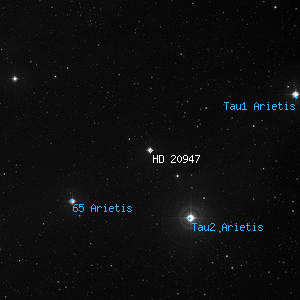HD 20947

Overlaid DSS image of HD 20947, 60' x 60' with north at top and west to the right
Aladin viewer for the region around HD 20947
Σ 381, BD+20 554, WDS J03233+2058AB, SAO 75906, GSC 01245-00245
| Type | |
|---|---|
| Magnitude | 7.22 | Right Ascension | 3h 23' 19.3" (2000) |
| Declination | 20° 58' 14" N |
| Constellation | Aries |
| Description | Binary 7.22/8.71 1.1" 109° |
| Classification | G5 |
Observing Notes
Captain William Henry Smyth
Mar 11, 1834 No. 6 The Crescent, Bedford, England (map)
150mm f/17.6 refractor by Tully 1827
A close double star, just following the tail of Aries, at about one-third of the distance between δ Arietis and the Pleiades. A 8, pearl white; B 9, yellow. This exquisitely delicate object is in a line with two distant stars of the 10th magnitude in the sp quadrant, and there is another small one in the nf: it is Σ.'s No. 381, "oblongam suspicor," and was thus first measured by its discoverer:Pos. 93°7 Dist. 0".75 Ep. 1827.16The elongation is not immediately detected; and the focus was slightly distorted to examine the outline of the spurious disc. This, if well managed, is often of great use on such occasions. This star forms an angle of 28° from τ2 Arietis, 45 P. Hora III., with a distance of 16'; but though so distant from each other, it is singular that there appears to be a slight movement in space, partaken by both, in quantities of similar amount and denomination.
[WDS 109° 1".10 2018 ]― A Cycle of Celestial Objects Vol II, The Bedford Catalogue, William Henry Smyth, 1844
Other Data Sources for HD 20947
Nearby objects for HD 20947
4 objects found within 120'
| 65 Arietis | 66 Arietis | |
| Tau2 Arietis |
Credits...
Drawings, descriptions, and CCD photos are copyright Andrew Cooper unless otherwise noted, no usage without permission.
A complete list of credits and sources can be found on the about page
HD 20947